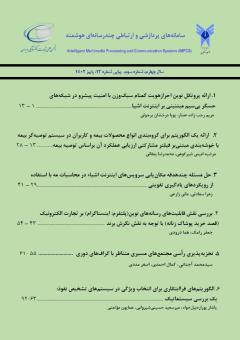ارائه یک الگوریتم برای گروه بندی انواع محصولات بیمه و کاربران در سیستم توصیه گر بیمه با خوشه بندی مبتنی بر فیلتر مشارکتی ارزیابی عملکرد آن براساس توصیه بیمه
محورهای موضوعی : پردازش چند رسانه ای، سیستمهای ارتباطی، سیستمهای هوشمندمرضیه امینی شیرکوهی 1 , محمدرضا یمقانی 2 *
1 - کارشناسی ارشد، کامپیوتر، واحد لاهیجان، دانشگاه آزاد اسلامی، لاهیجان، ایران
2 - استادیار، کامپیوتر، واحد لاهیجان، دانشگاه آزاد اسلامی، لاهیجان، ایران
کلید واژه: سیستم های توصیه گر, فیلترینگ مشارکتی, خوشه بندیk-means, بیمه,
چکیده مقاله :
با پیشرفتهایی که در صنعت بیمه صورت گرفته است، افراد زیادی برای دریافت خدمات بیمهای به شرکتهای دولتی و خصوصی بیمه مراجعه میکنند. پیش بینی اینکه مشتریان چه نوع بیمهای مناسب آن ها است و با توجه به شرایط فردی و اجتماعی به خصوص سطح درآمد کدام بیمه را ممکن است انتخاب کنند امری حیاتی است. در صنعت بیمه می توان با پیش بینی نوع بیمه ی انتخابی برای هر مشتری کار را برای افرادی که قصد خرید بیمه دارند و همچنین بیمه گزاران تا حد زیادی آسان کرد. خوشهبندی مشتریان، تحلیل ویژگیهای هر خوشه و دریافت اینکه در هر خوشه کدام بیمهها پرطرفدار هستند سپس استفاده از تکنیک فیلترینگ مشارکتی برای ارائه توصیه خرید بیمه به مشتریان، می تواند در روند تصمیم گیری و خرید خدمات بیمه ای موثر باشد. با استفاده از داده های موجود در مورد ویژگیهای فردی و اجتماعی افراد و نوع بیمههایی که انتخاب میکنند به همراه میزان رضایت آنها از خدمات بیمهای در صنعت بیمه میتوان به پیش بینی رفتار مشتری پرداخت و این امر با استفاده از الگوریتم خوشه بندی k-means و استفاده از تکنیک های سیستمهای توصیهگر مانند فیلترینگ مشارکتی تا حد زیادی میسر میشود.
Introduction: There are many improvements in insurance industries in these decades. So Many people refer to public and private insurance companies to get insurance services. They usually face to some challenges and issues for selecting the best and suitable insurance because of various type of insurance and lack of enough information of insurance service. Choosing the proper insurance service always related to people personal and social features.
Method: Prediction of customer’s insurance selection according to people personal and social property especially thier financial condition play vital role. On one hand Prediction of insurance type can help people who want to utilize insurance service. On the other hand this prediction can facilitate process of insurance for Insurers too. There are multiple important mechanisms and factors like customers clustring, analyze each class feature, detection of popular insurance in each class and using Collaborative filtering technique to offer best insurance that can influence on process of decision and selection the suitable insurance.
Results: The total precision value of the proposed method is 89.98% for joint insurances of similar users. Also, the total value of the F-measure of the proposed method for joint insurances between similar customers is 87.13%.
Discussion: Customer behavior can be predicted by available data of people’s personal and social features and type of insurance that they are chosen and rate of their satisfactions. K-means clustring algorithm and recommender systems Techniques like Collaborative filtering are two significant mechanisms to implement prediction of customer’s behaviors.
[1] J. Neidhardt, T. Kuflik and W. Wörndl, “Special section on recommender systems in tourism,” Information Technology & Tourism, vol. 19, no. 1, pp. 83-85, 2018
[2] T.N. Nguyen and F. Ricci, “A chat-based group recommender system for tourism,” Information Technology & Tourism, vol. 18, no. 1, pp. 5-28, 2018.
[3] Bazargani, Mehdi, & Homayunpour, Zainab. (2019). Presenting a new method to discover the nearest neighbor in recommender systems based on collaborative filtering. Intelligent Multimedia Communication and Processing Systems, 1(1), 55-64.
[4] Manteghipour, Mahnaz, & Rahimkhani, Parisa. (1401). Designing a hybrid model for classification of imbalanced data in the field of Casualty Insurance. Intelligent multimedia processing and communication systems, 3(2), 1-9.
[5] M. Jalili, S. Ahmadian, M. Izadi, P. Moradi and M. Salehi, “Evaluating collaborative filtering recommender algorithms: a survey,” IEEE access, vol. 6, pp. 74003-74024, 2018.
[6] W.S. Lin, N. Cassaigne and T.C. Huan, “A framework of online shopping support for information recommendations,” Expert Systems with Applications, vol. 37, no. 10, pp. 6874-6884, 2010.
[7] L. Zhang, J. Zhu and Q. Liu, “A meta-analysis of mobile commerce adoption and the moderating effect of culture”, Computers in human behavior, vol. 28, no. 5, pp. 1902-1911, 2012.
[8] A. Salah, N. Rogovschi and M. Nadif, “A dynamic collaborative filtering system via a weighted clustering approach”, Neurocomputing, vol. 175, pp. 206-215, 2016.
[9] M. Taghizadeh, “A review of filtering methods in recommender systems”, 6th National Conference on Computer Science and Engineering and Information Technology, 859097, 2018. [Persian].
[10] M. Khamisi, S. Samiri, “Review and comparison of collaborative filtering algorithm in recommender systems”, International Conference on Science, Engineering, Technology and Technological Businesses, 903155, 2018. [Persian].
[11] F. Pajuelo-Holguera, J.A. Gómez-Pulido, F. Ortega and J.M. Granado-Criado, “Recommender system implementations for embedded collaborative filtering applications”, Microprocessors and Microsystems, vol. 73, p. 102997, 2020.
[12] S.K. Panda, S. K. Bhoi and M. Singh, “A collaborative filtering recommendation algorithm based on normalization approach”, Journal of Ambient Intelligence and Humanized Computing, vol. 11, no. 11, pp. 4643-4665, 2020.
[13] Yao, S., Halpern, Y., Thain, N., Wang, X., Lee, K., Prost, F., ... & Beutel, A. (2021). Measuring recommender system effects with simulated users. arXiv preprint arXiv:2101.04526.
[14] Teixeira, B., Martinho, D., Novais, P., Corchado, J., & Marreiros, G. (2022, August). Diabetic-Friendly Multi-agent Recommendation System for Restaurants Based on Social Media Sentiment Analysis and Multi-criteria Decision Making. In EPIA Conference on Artificial Intelligence (pp. 361-373). Cham: Springer International Publishing.
[15] Cui, Y. (2021). Intelligent recommendation system based on mathematical modeling in personalized data mining. Mathematical Problems in Engineering, 2021, 1-11.

